radio AUDI A6 2017 Owners Manual
[x] Cancel search | Manufacturer: AUDI, Model Year: 2017, Model line: A6, Model: AUDI A6 2017Pages: 280, PDF Size: 70.24 MB
Page 31 of 280
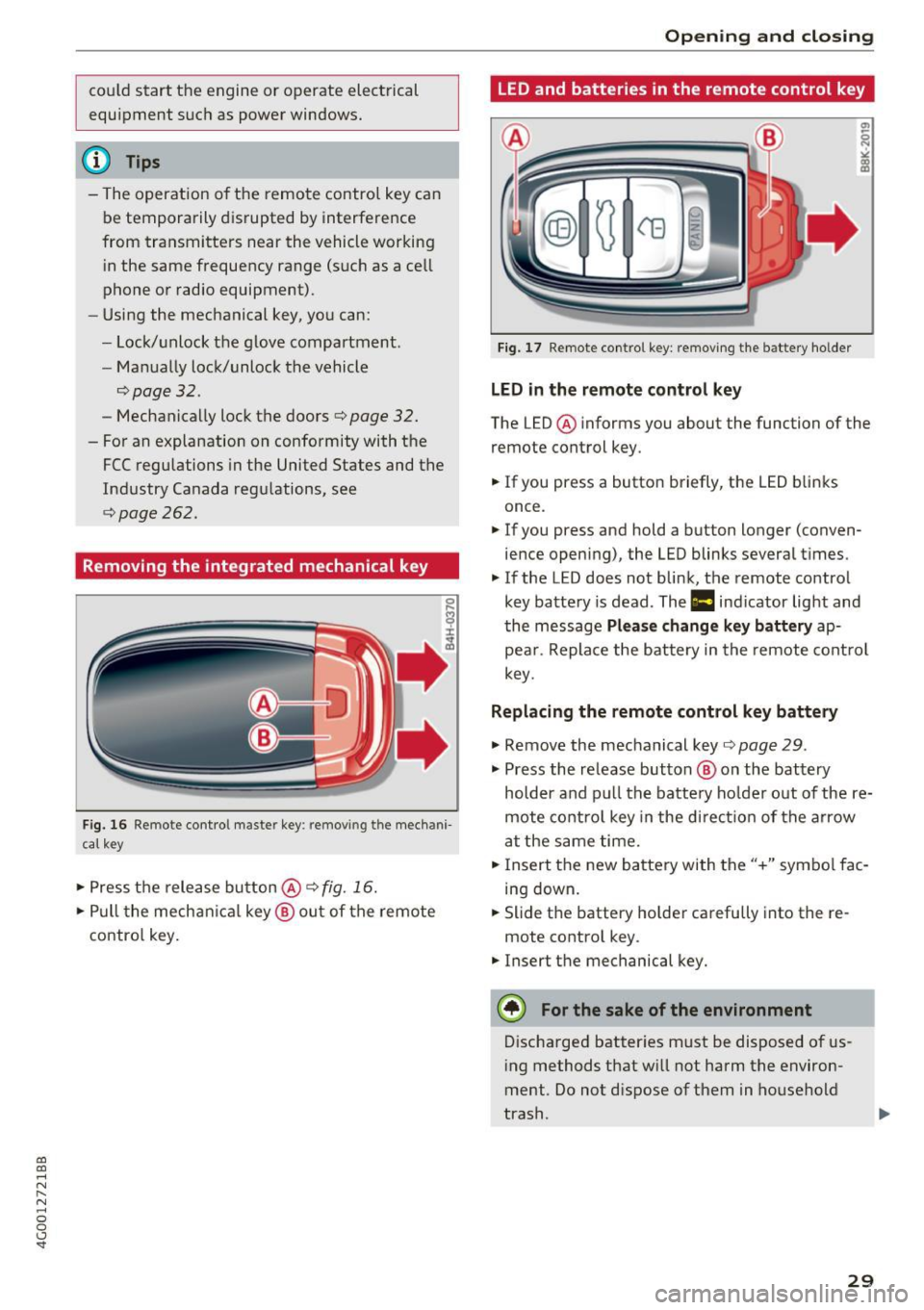
co
co
.... N
" N .... 0 0 <..:l 'SI'
could start the engine or operate electrical
equipment such as power windows.
(D Tips
- The operation of the remote control key can
be temporarily disrupted by interference
from transmitters near the vehicle working
i n the same frequency range (such as a cell
phone or radio equipment).
- Using the mechanical key, you can:
- Lock/unlock the glove compartment.
- Manually lock/unlock the vehicle
¢ page 32 .
-Mechanically lock the doors¢ page 32.
-For an explanation on conformity with the
FCC regulations in the United States and the
Industry Canada regulations, see
¢ page 262.
Removing the integrated mechanical key
Fig. 16 Remote contro l maste r key : remov ing t he mech ani
cal key
• Press the release button@¢ fig. 16.
• Pull the mechanica l key @ out of the remote
contro l key.
Open ing and closing
LED and batteries in the remote control key
Fig. 17 Remote control key: removing the battery holder
LED in the remote control key
The LED @ informs you about the function of the
remote control key.
• If you press a button briefly, the LED b links
once .
• If you press and hold a button longer (conven
ience opening), the LED blinks several times.
"' If the LED does not blink, the remote control
key battery is dead . The
1:1 indicator light and
the message
Please change key battery ap
pear . Replace the battery in the remote control
key.
Replacing the remote control key battery
"'Remove the mechanical key ¢page 29 .
"' Press the release button @ on the battery
holder and pull the battery ho lder out of the re
mote control key in the di rect io n of the arrow
at the same time.
• Insert the new battery with the"+" symbol fac
ing down.
• Slide the battery holder carefully into the re
mote control key.
"' Insert the mechanical key.
@) For the sake of the environment
Discharged batter ies must be disposed of us
ing methods that w ill not harm the environ
ment . Do not dispose of them in household
trash.
29
Page 38 of 280
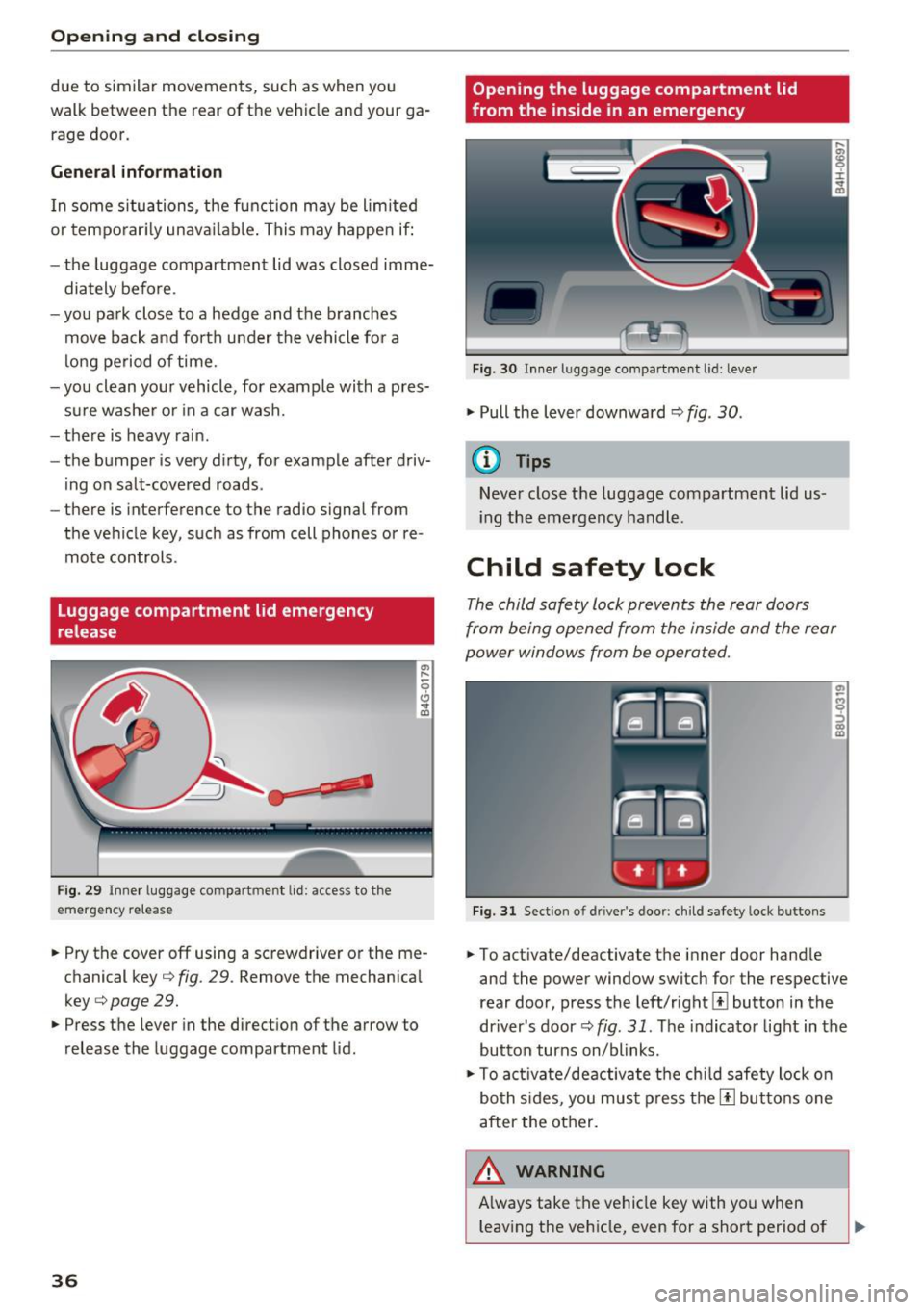
Opening and clo sin g
due to similar movements, such as when you
walk between the rear of th e vehicle and your ga
rage door.
General inform ation
I n some situations, the function may be lim ited
or tempo rar ily unava ilable . This may happen if :
- the luggage compartment lid was closed imme diately before .
-you park close to a hedge and the branches move back and forth under the vehicle for a
long period of time.
- you clean your vehicle , fo r example with a pres
sure washe r or i n a car wash.
- there is heavy rain.
- the bumper is very dirty , for example after driv-
ing on salt-covered roads .
- there is interference to the radio signal from
the ve hicle key, such as from cell phones or re
mote controls .
Luggage compartment lid emergency
release
F ig . 29 Inner luggage compart men t lid : access to the
emergen cy re le ase
.,. Pry the cover off using a screwdriver or the me
chan ical key ¢
fig. 29 . Remove the mechan ica l
key ¢
page 29 .
.,. Press the lever in the direct ion of the arrow to
release the luggage compartment lid .
36
Opening the luggage compartment lid
from the ins ide in an emergency
Fig. 30 I nne r luggage compart ment l id : leve r
.,. Pull the lever downward¢ fig. 30 .
(D Tips
Never close t he luggage compartment lid us
i ng the emergency handle .
Child safety lock
The child safety lock prevents the rear doors
from being opened from the inside and the rear
power windows from be operated.
Fig. 31 Sect ion o f dri ver's doo r: ch ild safety loc k bu ttons
.,. To activate/deactivate the inner door hand le
and the power window switch for the respective
rear doo r, press the left/rightl±l button in the
driver's door¢
fig. 31 . The indicator light in the
button turns on/blinks .
.,. To act ivate/deactivate the chi ld safety lock o n
bo th s ides, you mus t press the [!l but tons one
after the other.
A WARNING , ~
A lways take the vehicle key with you when
leaving the veh icle, even for a short period of
Page 127 of 280

co
co
.... N
" N .... 0 0 <..:l '
battery diagno sis , idling current management ,
and dynamic energy management.
Battery diagnosis
The batte ry diagnosis determines the vehicle bat
tery charge level. The sensors detect the battery,
the battery current, and the battery temperature.
The current charge leve l and the performance of
the vehicle battery are determined based on this.
Idling current management
The idl ing current management decreases the
energy used whi le pa rked . With the engine
switched off, it manages the energy distribution
to the different electrical components . Data from
the battery diagnosis is taken into account for
this.
Depending on the vehicle battery charge level,
e lectrical equipment is switched off one item af
ter the other to prevent the vehicle battery from
draining and to maintain the starting ability.
Dynamic energy management
While driving, dynamic energy management dis
tributes the appropriate amount of energy to the
e lectrical equipment. It controls the battery
charge level so that the amount of energy is not
greater than the amount being generated in or
der to mainta in an optimal veh icle battery charge
level.
(D Tips
- Energy management cannot overcome the
laws of physics . Note that the charge level
and length of the vehicle battery life are
limited.
- When the start ing ability is endangered, the
(•) indicator light turns on
~ page 14.
What you should know
Maintaining the starting ability is the highest
priority.
A lot of stress is placed on the vehicle battery
when dr iving short distances, during c ity dr iving,
and at cold times of the year . A lot of energy is
Intelligent Technology
u sed but little is generated. It is also critical
when the engine is not running but electrical
equipment is switched on. In this case, energy is
used but none is generated.
In situations like this, energy management wi ll
active ly regulate the distribution of energy .
Long periods without use
If you do not drive your vehicle for severa l days or
weeks, electrical equ ipment is gradually scaled
back or switched off. This reduces energy use and
ensures the vehicle will be able to start after long
periods of time . Some convenience functions,
s u ch as interior lighting or power seat ad just
ment, may not be ava ilable under certain circum
stances. These conven ience functions will be
available again once you switch the ignition on
and start the engine.
With the engine switched off
The vehicle battery will dra in if you use Infotain
ment functions such as listening to the radio
whi le the engine is switched off .
T he vehicle's ability to start may be impaired by
the energy use, a message will appear in the In
fotainment system display.
The message indicates that the system wi ll
switch off automatically soon. If you would like
to continue using the functions, you must start
the engine.
With the engine running
Although e lectr ica l ene rgy is generated while
driving , the vehicle battery can drain. This can
happen if litt le energy is generated but much is
used, and the charge level of the vehicle battery
is not optimal.
To restore the balance of energy, components
that require large amounts of energy are tempo rarily scaled back or sw itched off. Heat ing sys
tems in particular requ ire a great deal of energy.
If you notice, for example, that the seat heating*
or rear window defogger is not work ing, then it
has been tempora rily reduced or sw itched off.
Th ese systems are available again as soon as the
energy supply has been restored. .,.
125
Page 164 of 280
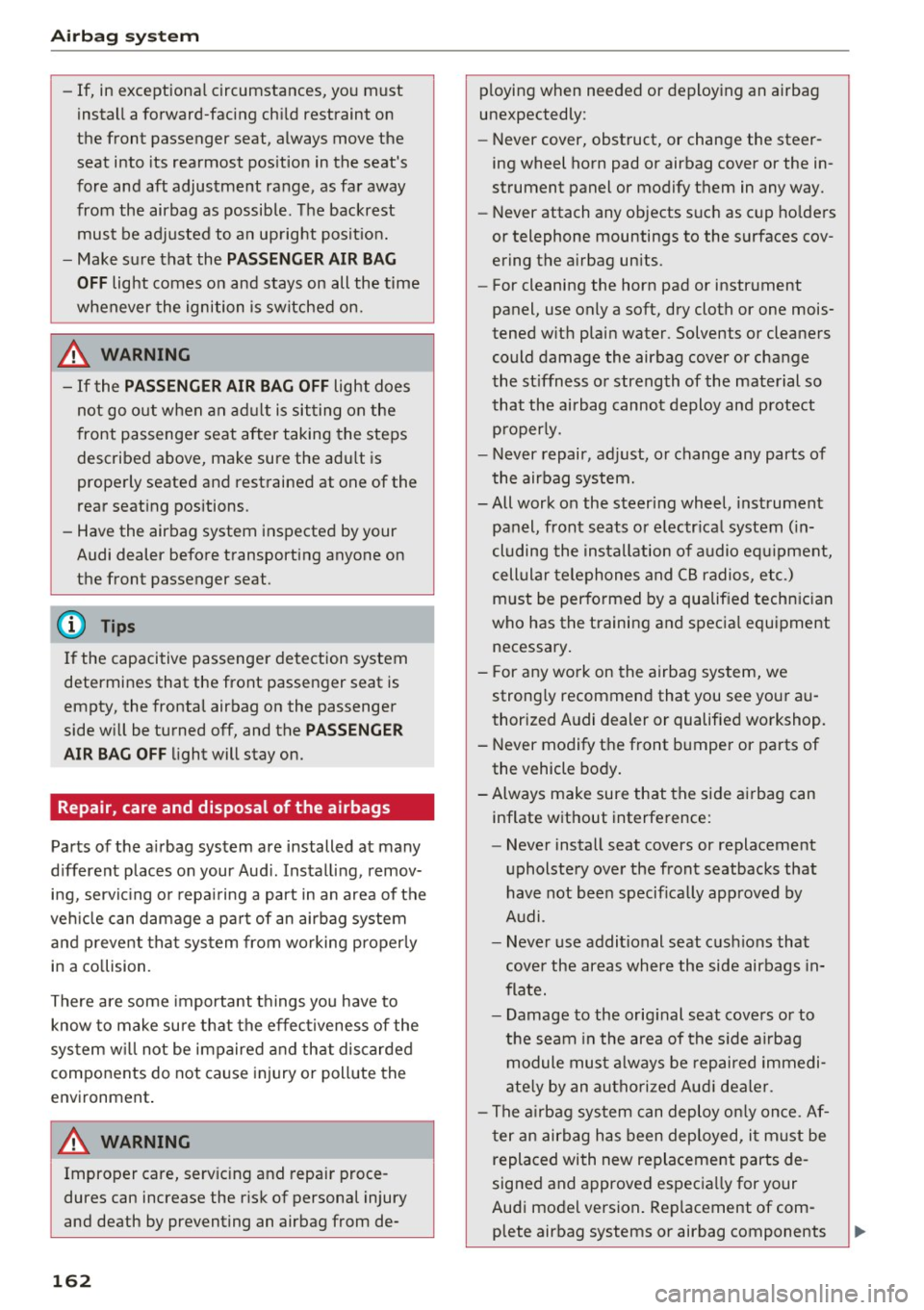
Airbag system
-If, in exceptional circumstances, you must
install a forward-facing child restraint on
the front passenger seat, always move the
seat into its rearmost position in the seat 's
fore and aft adjustment range , as far away
from the airbag as possible . The backrest
must be adjusted to an upright position.
- Make sure that the
PASSENGER AIR BAG
OFF
light comes on and stays on all the time
whenever the ignition is switched on.
_& WARNING
-If the PASSENGER AIR BAG OFF light does
not go out when an adult is sitting on the
front passenger seat after taking the steps
described above, make sure the adult is
properly seated and restrained at one of the
rear seating positions .
- Have the airbag system inspected by your
Audi dealer before transporting anyone on
the front passenger seat .
@ Tips
If the capacitive passenger detection system
determines that the front passenger seat is
empty, the frontal airbag on the passenger
side will be turned
off, and the PASSENGER
AIR BAG OFF
light will stay on.
Repair , care and disposal of the airbags
Parts of the airbag system are installed at many
different places on your Audi. Installing , remov
ing, servicing or repairing a part in an area of the
vehicle can damage a part of an airbag system
and prevent that system from working properly
in a collision .
There are some important things you have to
know to make sure that the effectiveness of the
system will not be impaired and that discarded
components do not cause injury or pollute the
environment.
A WARNING
Improper care, servicing and repair proce
dures can increase the risk of personal injury
and death by preventing an airbag from de-
162
ploying when needed or deploying an airbag
unexpectedly :
- Never cover, obstruct, or change the steer
ing wheel horn pad or airbag cover or the in
strument panel or modify them in any way .
- Never attach any objects such as cup holders
or telephone mountings to the surfaces cov
ering the airbag units .
- For cleaning the horn pad or instrument
panel, use only a soft, dry cloth or one mois
tened with plain water. Solvents or cleaners could damage the airbag cover or change
the stiffness or strength of the material so
that the airbag cannot deploy and protect properly.
- Never repair , adjust, or change any parts of
the airbag system.
-All work on the steering wheel, instrument
panel, front seats or electrical system (in
cluding the installation of audio equipment,
cellular telephones and CB radios, etc.) must be performed by a qualified technician
who has the training and special equipment
necessary.
- For any work on the airbag system, we
strongly recommend that you see your au
thorized Audi dealer or qualified workshop.
- Never modify the front bumper or parts of the vehicle body.
- Always make sure that the side airbag can inflate without interference:
- Never install seat covers or replacement
upholstery over the front seatbacks that
have not been specifically approved by
Audi .
- Never use additional seat cushions that
cover the areas where the side airbags in
flate.
- Damage to the original seat covers or to
the seam in the area of the side airbag
module must always be repaired immedi
ately by an authorized Audi dealer .
- The airbag system can deploy only once. Af
ter an airbag has been deployed, it must be
replaced with new replacement parts de
signed and approved especially for your
Audi model version. Replacement of com
plete airbag systems or airbag components
Page 214 of 280
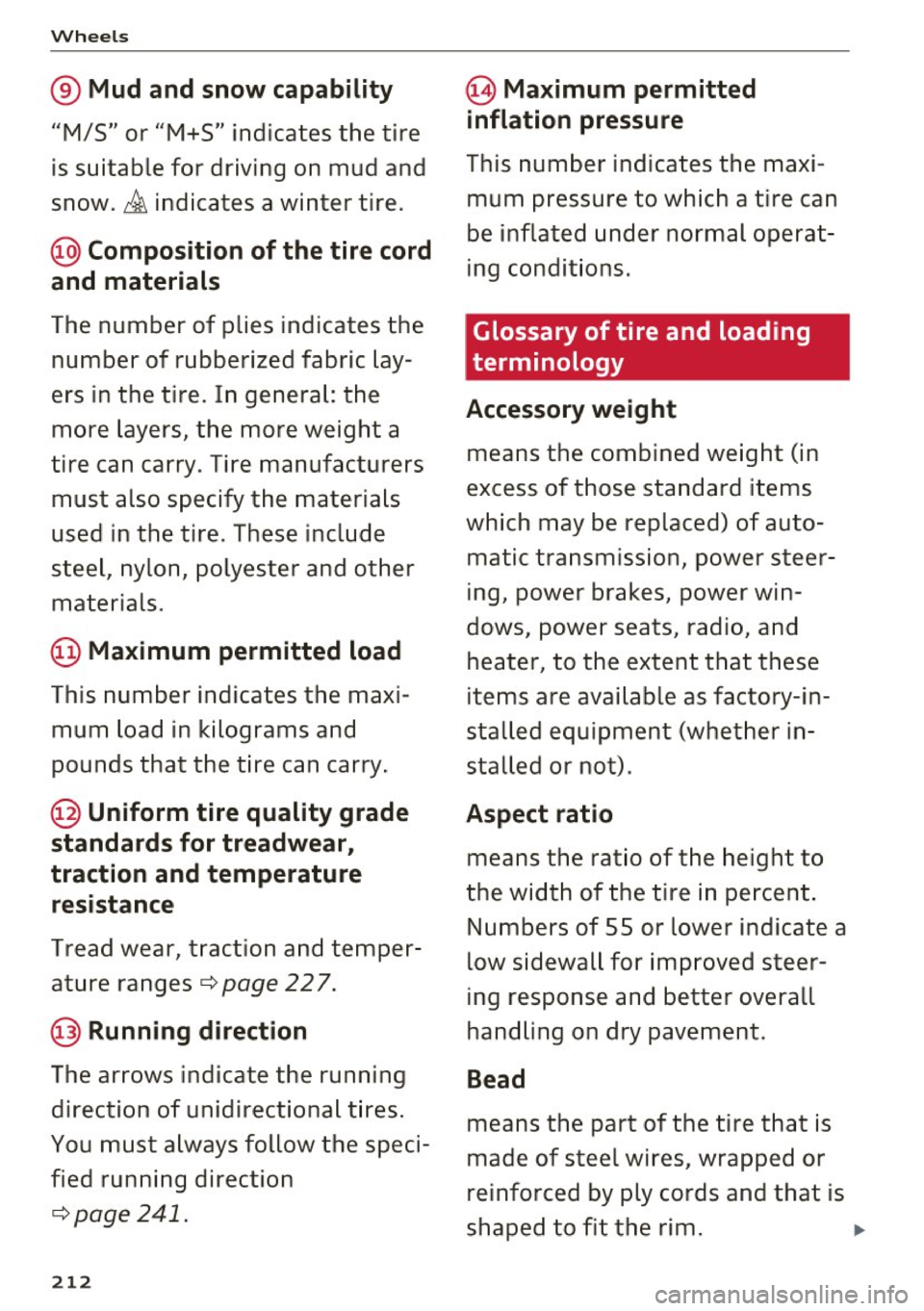
Wheel s
® Mud and snow capability
"M/5" or "M+S" indicates the tire
is sui table for driving on mud and
snow.
& indicates a winter tire.
@ Composition of the tire cord
and materials
The number of plies indicates the
number of rubberized fabric lay
ers in the t ire. In general: the
more layers, the more weight a
tire can carry . Tire manufacturers
must also specify the materials
used in the tire. These include
steel, nylon, po lyester and other
materials.
@ Maximum permitted load
This number indicates the maxi
mum load in kilograms and
pounds that the tire can carry .
@Uniform tire quality grade
standards for treadwear,
traction and temperature resist ance
Tread wear, traction and temper
ature ranges¢
page 227.
@ Running direction
The arrows indicate the running
direction of unidirectional t ires .
You must always follow the speci
fied running direction
¢page 241 .
212
@ Ma ximum permitted
inflation pressure
This number indicates the maxi
mum pressure to which a tire can
be inflated under normal operat
ing condit ions.
Glossary of tire and loading
terminology
Acces sory we ight
means the combined weight (in
excess of those standard items
which may be replaced) of auto matic transmission, power steer
ing, power brakes, power win
dows, power seats, radio, and
heater, to the extent that these
items are available as factory-in
stalled equipment (whether in
stalled or not) .
Aspect ratio
means the ratio of the height to
the width of the tire in percent .
Numbers of 55 or lower indicate a
low sidewall for improved steer
ing response and better overall
handling on dry pavement.
Bead
means the part of the tire that is
made of steel wires, wrapped or
reinforced by ply cords and that is
shaped to fit the r im . ...
Page 251 of 280
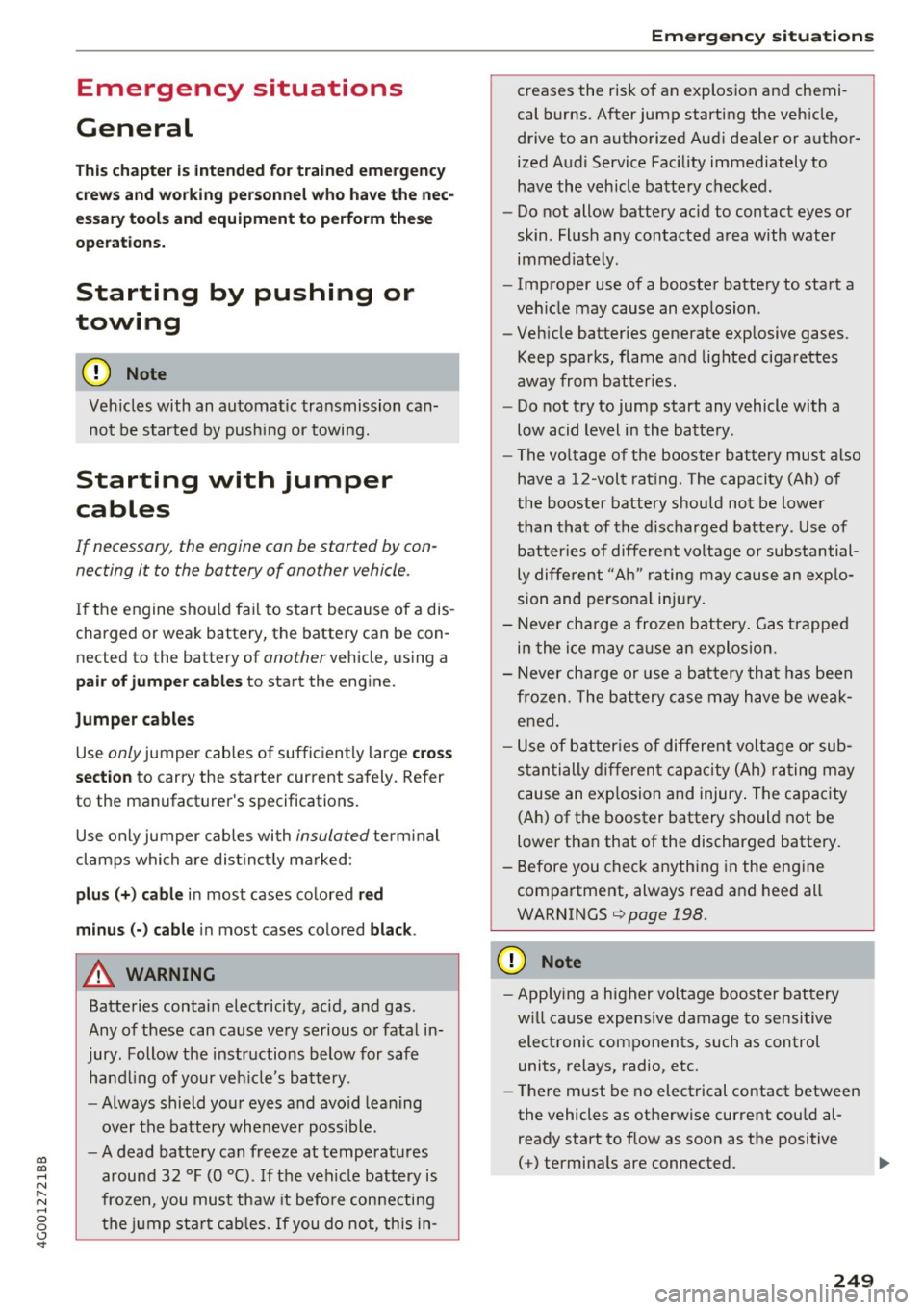
co
co
.... N
" N .... 0 0 <..:l '
General
This chapter is intended for trained emergency
crews and working personnel who have the nec
essary tools and equipment to perform these
ope rations.
Starting by pushing or
towing
CD Note
Veh icles with an automatic transmission can
not be started by pushing or towing.
Starting with jumper
cables
If necessary, the engine can be started by con
necting it to the battery of another vehicle.
If the engine shou ld fail to start because of a dis
charged or weak battery, the battery can be con
nected to the battery of
another vehicle, using a
pair of jumpe r cables to start the engine.
Jumper cables
Use only jumper cables of suffic iently large cross
section
to carry the starter current safely. Refer
to the manufacturer's specifications.
Use only jumper cables with
insulated term inal
clamps which are dis tinct ly marked:
plus (+) cable in most cases colored re d
minus( -) cable
in most cases colored black.
A WARNING
Batteries contain electricity, acid, and gas.
Any of these can cause very serious or fatal in
jury. Follow the instructions below for safe
handling of your vehicle's battery.
- Always shield your eyes and avo id leaning
over the battery whenever poss ible.
- A dead battery can freeze at temperatures
around 32 °F (0 °C). If the vehicle battery is
frozen, you must thaw it before connecting
the jump start cab les. If you do not, this in-
Emergency situations
creases the risk of an explosion and chemi
cal burns. After jump starting the vehicle,
drive to an authorized Aud i dealer or author
ized Audi Service Facility immediately to
have the vehicle battery checked.
- Do not allow battery ac id to contact eyes or
skin . Flush any contacted area with water
immed iately.
- Improper use of a booster battery to start a
veh icle may cause an explosion .
- Veh icle batteries generate explosive gases.
Keep sparks, flame and lighted cigarettes
away from batter ies.
- Do not try to jump start any vehicle with a
low acid level in the battery .
- The voltage of the booster battery must also
have a 12-volt rat ing . The capacity (Ah) of
the booster battery should not be lower
than that of the discharged battery. Use of
batter ies of different voltage or substantial
ly different "Ah" rating may cause an exp lo
sion and personal injury.
- Never charge a frozen battery. Gas trapped
in the ice may cause an explosion.
- Never charge or use a battery that has been
frozen . T he battery case may have be weak
ened.
- Use of batteries of different voltage or sub
stantially different capacity (Ah) rating may
cause an exp losion and injury . The capacity
(Ah) of the booster battery should not be
lower than that of the discharged battery.
- Before you check anything in the engine
compartment, always read and heed all
WARNINGS
qpage 198.
CD Note
-App lying a higher voltage booster battery
wi ll ca use expensive damage to sensitive
electronic components, such as control
units, relays, radio, etc.
- There must be no electrical contact between
the vehicles as otherwise current could al
ready start to flow as soon as the positive
(+) terminals are connected.
249
Page 264 of 280

Consumer inf orm ation
Attempting to work on electronic components
and the software used with them can cause mal
functions. Because of the way e lectronic compo
nents are interconnected with each other, such
malfunct ions can also have an adverse affect on
other systems that are not directly involved . This
means that you risk both a substantial reduction
in the operationa l safety of your veh icle and an
i n creased wea r of ve hicle parts ~ ,&. .
Author ized Audi dealers w ill perform this work in
a profess io nal and competent manner or, in spe
cial cases, refer you to a p rofessional company
that spec ial izes in such modifications.
_8. WARNING
Improper repairs and modifica tions can
change the way vehicle system s work and
cause damage to the vehicle and serious per
sonal injury.
(J} Note
I f emergency repa irs mus t be pe rformed else
where, have the vehicle examined by an a u
thorized A udi dealer as soon as possib le .
Declaration of
Compliance, Telecom munication and
Electronic Systems
Radio Frequency Devices and Radiocommunica
tion Equipment User Manual Notice.
The manufacturer is not responsible for any radio
or TV interference caused by unauthorized modi
f ications to this eq uipment .
Devices
The fo llow ing devices each comp ly w it h FCC Part
15 .19, FCC 15.2 1 and RSS -Gen Issue 1:
- Adaptive c ruise contro l*
- Audi s ide ass ist*
- Cell phone package*
- Convenience key*
- Electronic immobilizer
- Ga rage door opener (Homelink)*
- Remo te control key
262
FCC Part 15.19
This device complies wi th part 15 o f the FCC
Rules . Operation is subject to the fo llowing two
condit ions:
(1) This dev ice may not c ause ha rmf ul interfer
ence , and
(2) this dev ice must accept any inte rference re
ce ived, in cl ud ing interfe rence that may cause un
desire d ope ra tion.
FCC Part 15.21
CAUTION :
Changes or modificat ions not express ly approved
by the party responsible for compliance could
vo id the user's a uthority to operate the equ ip
ment .
RSS-G en Is sue 1
Operat ion is s ubject to the following two cond i
tions:
(1) this dev ice may not cause inte rfe rence, and
(2) this dev ice must accept any inte rference, in
clud ing in te rfe rence that may cause undesi red
ope ration o f the dev ice.
Page 268 of 280
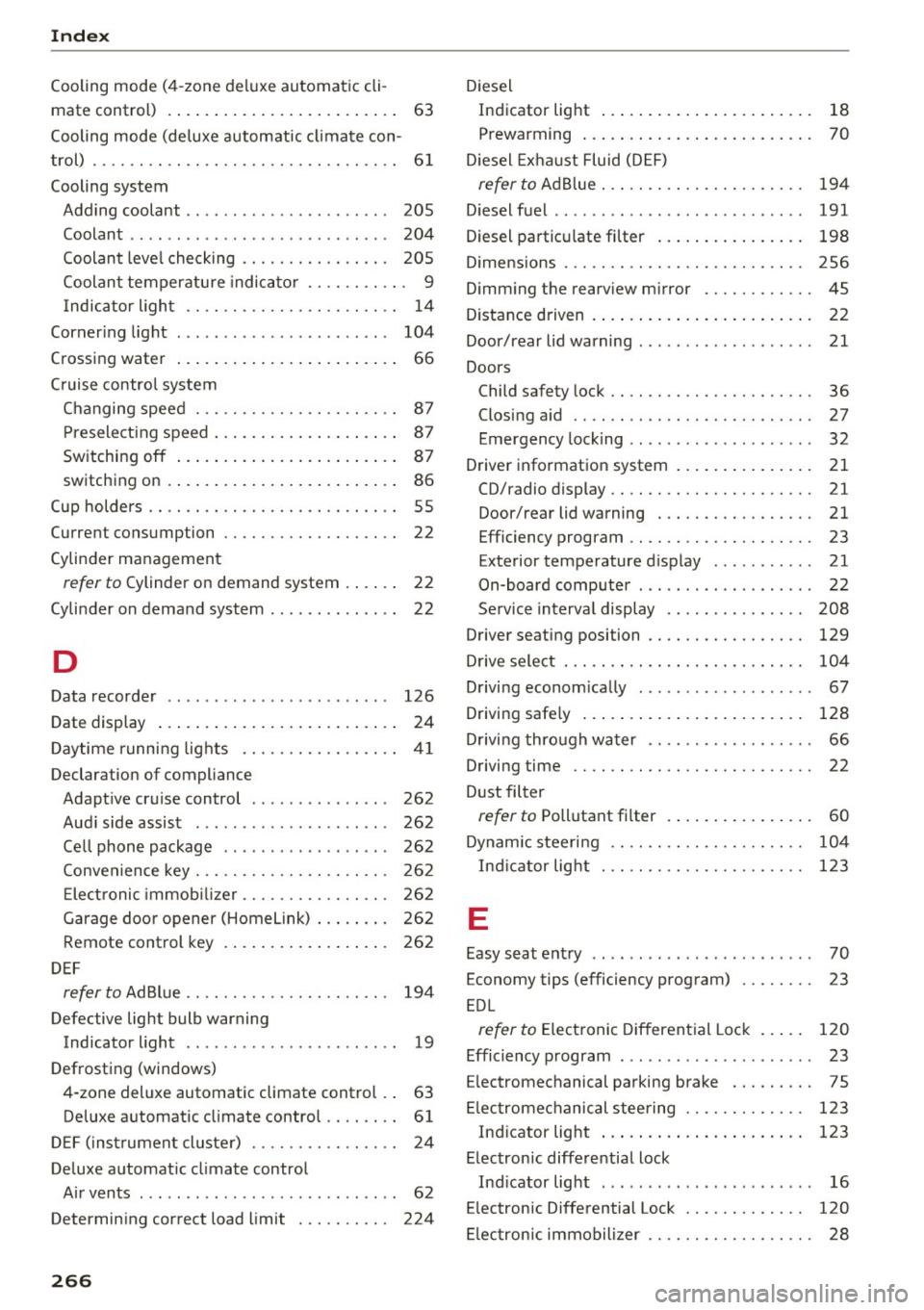
Index
Cooling mode (4-zone deluxe automatic cli-
mate control) . . . . . . . . . . . . . . . . . . . . . . . . . 63
Cooling mode (deluxe automatic climate con-
trol) . . . . . . . . . . . . . . . . . . . . . . . . . . . . . . . . . 61
Cooling system Adding coolant . . . . . . . . . . . . . . . . . . . . . . 205
Coolant . . . . . . . . . . . . . . . . . . . . . . . . . . . . 204
Coolant level checking . . . . . . . . . . . . . . . . 205
Coolant temperature indicator . . . . . . . . . . . 9
I ndicator light . . . . . . . . . . . . . . . . . . . . . . . 14
Cornering light . . . . . . . . . . . . . . . . . . . . . . . 1 04
Crossing water . . . . . . . . . . . . . . . . . . . . . . . . 66
Cruise control system Changing speed . . . . . . . . . . . . . . . . . . . . . . 87
Preselecting speed . . . . . . . . . . . . . . . . . . . . 87
Switching
off . . . . . . . . . . . . . . . . . . . . . . . . 87
switching on . . . . . . . . . . . . . . . . . . . . . . . . . 86
Cup holders . . . . . . . . . . . . . . . . . . . . . . . . . . . 55
Current consumption . . . . . . . . . . . . . . . . . . . 22
Cylinder management
refer to Cylinder on demand system . . . . . . 22
Cylinder on demand system . . . . . . . . . . . . . . 22
D
Data recorder . . . . . . . . . . . . . . . . . . . . . . . . 1 26
Date display . . . . . . . . . . . . . . . . . . . . . . . . . . 24
Daytime running lights . . . . . . . . . . . . . . . . . 41
Declaration of compliance Adaptive cruise control . . . . . . . . . . . . . . . 262
Audi side assist . . . . . . . . . . . . . . . . . . . . . 262
Ce ll phone package . . . . . . . . . . . . . . . . . . 262
Convenience key . . . . . . . . . . . . . . . . . . . . . 262
Electronic immob ilizer. . . . . . . . . . . . . . . . 262
Garage door opener (Horne link) . . . . . . . . 262
Remote control key . . . . . . . . . . . . . . . . . . 262
DEF
refer to Ad Blue . . . . . . . . . . . . . . . . . . . . . . 194
Defective light bulb warning Indicator light . . . . . . . . . . . . . . . . . . . . . . . 19
Defrosting (windows) 4-zone d eluxe automatic climate control . . 63
Deluxe automatic climate cont rol . . . . . . . . 61
DEF (instrument cluster) . . . . . . . . . . . . . . . . 24
Deluxe automatic climate control Air vents . . . . . . . . . . . . . . . . . . . . . . . . . . . . 62
Determining correct load limit . . . . . . . . . . 224
266
Diesel
Indicator light . . . . . . . . . . . . . . . . . . . . . . . 18
Prewarming . . . . . . . . . . . . . . . . . . . . . . . . . 70
D iesel Exhaust Fluid (DEF)
refer to Ad Blue. .. .. .. ............. .. 194
D iesel fuel ........ ... ............. ... 191
Diesel particulate filter . . . . . . . . . . . . . . . . 198
D imensions . . . . . . . . . . . . . . . . . . . . . . . . . . 256
Dimming the rearview mirro r . . . . . . . . . . . . 45
Distance driven . . . . . . . . . . . . . . . . . . . . . . . . 22
Door/rear lid warning . . . . . . . . . . . . . . . . . . . 21
Doors Child safety lock . . . . . . . . . . . . . . . . . . . . . . 36
Closing aid . . . . . . . . . . . . . . . . . . . . . . . . . . 27
Emergency locking . . . . . . . . . . . . . . . . . . . . 32
Driver information system . . . . . . . . . . . . . . . 21
CD/radio display .. .. .. ............. ... 21
Door/rear lid warning . . . . . . . . . . . . . . . . . 21
Efficiency program . . . . . . . . . . . . . . . . . . . . 23
Exterior tern perature dis play . . . . . . . . . . . 21
On-board computer . . . . . . . . . . . . . . . . . . . 22
Service interva l display . . . . . . . . . . . . . . . 208
Driver se ating position . . . . . . . . . . . . . . . . . 129
Drive select . . . . . . . . . . . . . . . . . . . . . . . . . . 104
Driving econom ically . . . . . . . . . . . . . . . . . . . 67
Driving safely . . . . . . . . . . . . . . . . . . . . . . . . 128
Driving through water . . . . . . . . . . . . . . . . . . 66
Driving time . . . . . . . . . . . . . . . . . . . . . . . . . . 22
Dust filter
refer to Pollutant filter . . . . . . . . . . . . . . . . 60
Dynam ic steering . . . . . . . . . . . . . . . . . . . . . 104
Indicator light . . . . . . . . . . . . . . . . . . . . . . 123
E
Easy seat entry . . . . . . . . . . . . . . . . . . . . . . . . 70
Economy tips (efficiency program) . . . . . . . . 23
EDL
refer to Electronic Differential Lock . . . . . 120
Efficiency program . . . . . . . . . . . . . . . . . . . . . 23
E lectromechanical parking brake . . . . . . . . . 75
Electromechanical steering . . . . . . . . . . . . . 123
Indicator light . . . . . . . . . . . . . . . . . . . . . . 123
Electronic differential lock
Ind icator light . . . . . . . . . . . . . . . . . . . . . . . 16
Electronic Differential Lock . . . . . . . . . . . . . 120
E lectronic immobilizer . . . . . . . . . . . . . . . . . . 28